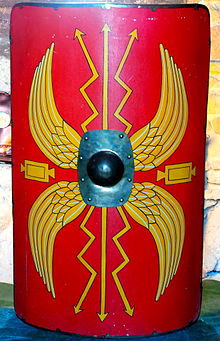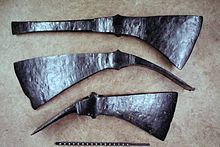Roman military equipment
The weapons and equipment of a soldier in the Roman army are listed here according to topic. The period includes the republic , the imperial era and late antiquity .
weapons
Cutting and stabbing weapons
Gladius
The gladius was a sword that soldiers carried on the right side as a standard weapon . An imperial gladius was about 50–56 cm long, about 8 cm wide and sanded on both sides. His weight was between 1 and 1.5 kg. In the 3rd century it was replaced by the spathe .
Pugio
The pugio was a dagger that soldiers carried on the left side as a secondary weapon. The forerunner of the Pugio was the Parazonium . Another form of the dagger was the clunaculum .
Spathe
The Roman spathe was between 75 cm and 110 cm long and always had a 4 to 6 cm wide blade of different cross-section with or without a fuller . The cutting edges ran parallel or with very little taper and were often selectively hardened. The place was mostly shaped like a point.
Lances and spears
Contus
Contus lances were between three and five meters long and were wielded with both hands in combat on horseback.
Hasta
The hasta was originally the soldiers' main combat weapon. With the beginning of the 1st century BC The hasta disappeared from the legions and was only used in the cavalry and by some auxiliary troops.
Pilum
The pilum was a further development of the throwing lance and essentially consisted of two parts, the approximately one meter long wooden shaft and a square or round forged iron rod that was usually approximately the same length and which was shaped into a square point at its tapering end.
Spiculum
The spiculum was a spear used by Roman soldiers in late antiquity .
Verutum
The verutum was an approximately 1–1.2 meter long spear that was used by lightly armed troops such as the Velites .
Others
Plumbata
protective gear
Body armor
Lorica Hamata
The Lorica Hamata was a mail shirt that was probably used since the 3rd century BC. Was used. It consisted of up to 30,000 iron rings and could weigh up to 10 kilograms.
Lorica Plumata
The Lorica Plumata was a special scale armor in which, in contrast to the Lorica Squamata, the scales were attached to a Lorica Hamata .
Lorica segmentata
The Lorica Segmentata is articulated, splinted or braced armor that came into use at the beginning of the 1st century AD. Depending on the thickness, number and size of the rails, Roman armor could weigh up to 14 kilograms.
Lorica Squamata
As Lorica Squamata will scale armor in the empire called.
Shields
Cetratus
The Cetratus was a light Roman shield. It was made of wood that was covered with leather.
Parma
In contrast to the scutum, the shield of a legionnaire , a Parma was not curved, but flat and round or oval in shape. It was used by members of the auxiliary troops and the cavalry.
Scutum
The scutum was a large oval, later rectangular, and always domed wooden shield . Initially oval in shape, the rectangular type prevailed in the middle of the 1st century AD. The shield, weighing around nine kilograms, was carried by a horizontal handle in the left hand. The rectangular scutum was about 120-130 cm high and about 60-70 cm wide.
Helmets
The Latin names for helmets were cassis and galea . While a cassis was always made of metal, the galea was originally a leather hood. A distinction is made between the following types of helmets:
Arm and leg protection
Manica
A manica is an armguard that extends from the shoulder to the hand.
Leg brace
Clothes and boots
Pants
Coats
Boots
The caligae were the marching boots of the Roman military.
tunic
Tools
Dolabra
A dolabra is an ancient tool that was used in particular for excavation work and is therefore also known as a "pioneer ax". It had two cutting edges on one shaft, one vertical and one horizontal. The Dolabra can therefore be described as a combination of ax and hoe .
Rutrum
The rutrum was a Roman spade .
Others
Cingulum and pteryges
The cingulum militare was a soldier's belt. The pteryges were strips of fabric or leather that were attached to the belt so that they hung in front of the crotch.
For about
The furca was a carrying pole carried by Roman legionaries during the march.
Sarcina
Sarcina is the name given to a legionnaire's baggage.
saddle
The riding saddle of Roman cavalrymen is called the croissant saddle .









